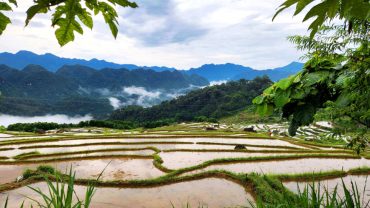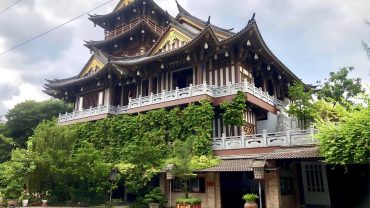Nestled in the heart of Ho Chi Minh City, **Giac Lam Pagoda** stands as one of Vietnam’s oldest and most revered spiritual landmarks. As a vital part of the city’s rich cultural heritage, Giac Lam Pagoda has been a center for Buddhist worship and a place of profound historical importance for nearly three centuries. This article will take you through the history, architecture, and spiritual significance of Giac Lam Pagoda, providing all the necessary information you need to explore this sacred site.
## Overview of Giac Lam Pagoda
[Giac Lam Pagoda](https://en.wikipedia.org/wiki/Gi%C3%A1c_L%C3%A2m_Temple) is not only a religious site but also an architectural treasure of Ho Chi Minh City. Located in the Tan Binh District, the pagoda was established in 1744, making it one of the oldest temples in the region. Known for its serene atmosphere and beautiful surroundings, Giac Lam Pagoda is a peaceful escape from the bustling life of the city.
The pagoda’s name, Giac Lam, translates to “Feel the Woods,” symbolizing the serene and quiet environment that surrounds this historical monument. Over the centuries, it has remained a significant site for local worshippers and an attraction for tourists seeking to learn more about the Buddhist heritage of Vietnam.
## Tracing the Historical Roots of Giac Lam Pagoda
### Early History and Founding
The founding of Giac Lam Pagoda dates back to 1744, during the reign of Lord Nguyen Phuc Khoat. It was initially established by Ly Thuy Long, a wealthy philanthropist who aimed to create a space for monks and devotees to practice Buddhism. Since then, the pagoda has served as a spiritual retreat for Buddhists across generations.
### The Role of Giac Lam Pagoda in Vietnamese Buddhism
Throughout its history, Giac Lam Pagoda has played an essential role in the development of Vietnamese Buddhism. It became a significant center for teaching and spreading Buddhist teachings in southern Vietnam. Many notable monks have studied and taught at the pagoda, and it has been a focal point of many religious and cultural events over the centuries.
Over the years, Giac Lam Pagoda has undergone several renovations, each of which added to its beauty and historical significance. Major renovations took place in 1798 and 1906, where new structures were added, including the iconic Avalokitesvara Bodhisattva statue and several other important religious statues. Despite these changes, the pagoda has maintained its original structure, which is typical of 18th-century Vietnamese Buddhist architecture.
[image-1|giac-lam-pagoda-overview|Giac Lam Pagoda overview|A wide-angle shot capturing the exterior of Giac Lam Pagoda. The frame showcases the temple’s multi-tiered roof adorned with intricate carvings, the vibrant red and gold color scheme, and lush greenery surrounding the structure. The image should highlight the grandeur and architectural beauty of the pagoda.]
## Unveiling the Timeless Architecture of Giac Lam Pagoda
### Exploring the Timeless Beauty of Vietnamese Buddhist Design
Giac Lam Pagoda is a prime example of traditional Vietnamese Buddhist architecture. The main temple consists of three parts: the ceremonial hall, the preaching hall, and the retreat hall. The layout of the pagoda is in the shape of the Chinese character “三” (three), symbolizing the unity between the Buddha, the Dharma, and the Sangha.
The pagoda is also famous for its intricately designed roof, adorned with statues of dragons and mythical creatures that represent protection and good fortune. The architectural style here has been preserved over the centuries, reflecting the cultural richness and spiritual depth of ancient Vietnamese temples.
### Iconic Statues and Symbols
One of the most iconic features of Giac Lam Pagoda is the 32-meter tall Avalokitesvara Bodhisattva statue, standing prominently in the temple grounds. This statue represents the Bodhisattva of Compassion, a central figure in Buddhist teachings. Visitors are also greeted by hundreds of other statues inside the temple, each with intricate designs and symbolic meanings, such as the Four Heavenly Kings and the Buddha himself.
### The Seven-Story Stupa
Another architectural highlight of Giac Lam Pagoda is its seven-story stupa, built in 1999. The stupa rises majestically within the pagoda’s courtyard and is a recent addition to the temple grounds. It serves as a reminder of Buddhist teachings and a place for devotees to meditate and reflect. The stupa is a popular spot for visitors seeking tranquility and a panoramic view of the surrounding areas.
[image-2|giac-lam-pagoda-interior|Giac Lam Pagoda Interior|A captivating shot of the interior of Giac Lam Pagoda’s main hall. The image should capture the rows of red pillars, intricate carvings on the walls and ceiling, and the soft glow of lanterns illuminating the space. The focal point of the picture should be a golden Buddha statue, adorned with offerings, positioned at the center of the hall.]
## Spiritual Importance of Giac Lam Pagoda
### A Center for Meditation and Growth
For centuries, Giac Lam Pagoda has been a place for spiritual retreat and meditation. Monks and practitioners gather here to study Buddhist scriptures, meditate, and participate in religious ceremonies. The peaceful environment and tranquil gardens make it an ideal location for anyone looking to deepen their spiritual practice.
The pagoda also serves as a center for Buddhist teachings, where visitors can attend lectures and learn about the fundamental aspects of the Buddhist faith. Many significant religious festivals are celebrated here, including Buddha’s Birthday, attracting both local worshippers and tourists.
### Pilgrimage Site for Buddhists
For devout Buddhists, Giac Lam Pagoda is considered a pilgrimage site. Pilgrims from all over Vietnam and neighboring countries come to the pagoda to pay homage, make offerings, and pray for blessings. The pagoda’s sacred atmosphere is further enhanced by the incense smoke that fills the air, adding a mystical element to the spiritual experience.
[image-3|giac-lam-pagoda-meditation|Meditation at Giac Lam Pagoda|A serene image of individuals meditating within the peaceful grounds of Giac Lam Pagoda. The photo could depict people meditating inside the temple or outdoors amidst the lush greenery, conveying a sense of tranquility and spiritual connection.]
## Visiting Giac Lam Pagoda
### How to Get There
Located about 7 kilometers from the center of Ho Chi Minh City, Giac Lam Pagoda is easily accessible by taxi, motorbike, or public transportation. Visitors can take a bus from Ben Thanh Market or rent a bike for a more adventurous approach. The journey to the pagoda takes you through the vibrant streets of the city before arriving at the peaceful retreat in Tan Binh District.
### Best Time to Visit
The best time to visit Giac Lam Pagoda is early in the morning or late afternoon when the temple grounds are less crowded. This allows for a more serene experience as you explore the pagoda’s architecture, statues, and gardens. The pagoda is open daily to visitors, and entrance is free, although donations are always appreciated.
### Tips for Visitors
Visitors to Giac Lam Pagoda should be respectful of the religious practices and cultural significance of the site. Wear modest clothing, and remember to remove your shoes before entering the temple. It’s also important to remain quiet while inside the pagoda to maintain the sacred and peaceful atmosphere.
Photography is allowed in most areas of the pagoda, but it’s always a good idea to ask for permission before taking pictures inside the main halls.
## Nearby Attractions
While Giac Lam Pagoda is a must-see destination in its own right, there are several other attractions nearby that visitors can explore. The Tan Binh District is home to several other temples, parks, and local markets, providing a well-rounded cultural experience.
### Cholon- Ho Chi Minh City’s Bustling Chinatown
Just a short drive from Giac Lam Pagoda, Cholon is the bustling Chinatown of Ho Chi Minh City. Here, visitors can explore traditional Chinese temples, vibrant markets, and sample delicious local cuisine. Cholon is a vibrant part of the city’s cultural landscape, offering a contrast to the peaceful atmosphere of Giac Lam Pagoda.
### War Remnants Museum
For those interested in Vietnam’s modern history, the War Remnants Museum is another important site to visit. Located in the city center, the museum offers a sobering look at the impact of the Vietnam War, with various exhibits showcasing the country’s wartime experiences and its aftermath.
[image-4|war-remnants-museum-exterior|War Remnants Museum Exterior|A photograph of the War Remnants Museum’s exterior, featuring its stark architecture and the words “War Remnants Museum” prominently displayed. The image should evoke a sense of history and solemnity.]
Giac Lam Pagoda is not just a place of worship, but a journey through Vietnam’s cultural, architectural, and spiritual heritage. Its historical significance, stunning architecture, and tranquil environment make it a must-visit destination for anyone traveling to Ho Chi Minh City. Whether you are seeking spiritual enlightenment, cultural enrichment, or simply a peaceful retreat from the city, Giac Lam Pagoda offers a unique and fulfilling experience.
As you walk through its sacred halls, past its towering statues, and under the shade of its ancient trees, you can feel the centuries of devotion and history that have shaped this remarkable place. Giac Lam Pagoda truly stands as a testament to the enduring beauty of Vietnam’s Buddhist traditions, making it a destination that should not be missed.
**Some tourist destinations in Ho Chi Minh City:**
* [Opera House Saigon](https://vntraveladvise.com/travel/opera-house-saigon/)
* [Cu Chi Tunnels](https://vntraveladvise.com/hotel/exploring-the-cu-chi-tunnels/)
* [History Museum of Ho Chi Minh City](https://vntraveladvise.com/travel/history-museum-of-ho-chi-minh-city/)




Comment (0)